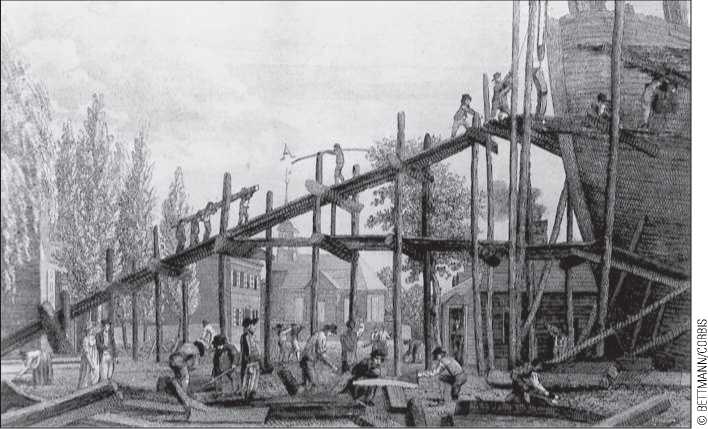Although large-scale manufacturing was not characteristic of colonial economic activity, shipbuilding was an important exception. As early as 1631, barely a decade after the Pilgrims landed at Plymouth, a 30-ton sloop was completed in Boston.
During the seventeenth century, shipyards sprang up all along the New England coast, with Boston and Newport leading the way. New York was a strong competitor until the
Copyright 2013 Cengage Learning. All Rights Reserved. May not be copied, scanned, or duplicated, in whole or in part. Due to electronic rights, some third party content may be suppressed from the eBook and/or eChapter(s). Editorial review has deemed that any suppressed content does not materially affect the overall learning experience. Cengage Learning reserves the right to remove additional content at any time if subsequent rights restrictions require it.
Navigation Act of 1651 (see chapter 4) dealt its Dutch-dominated industry a crippling blow, but the shipbuilding industry in New York again grew rapidly after 1720. By this time, Philadelphia boasted a dozen large shipyards along the banks of the Delaware River, and of the five major towns, only Charleston relied on ships produced by others. In the first half of the eighteenth century, the output of colonial shipyards reached its peak.
By 1700, the New England fleet exceeded 2,000 exclusive of fishing boats. American industry not only furnished the vessels for a large domestic merchant fleet, but also sold a considerable number of ships abroad, chiefly to the English. An uncontradicted estimate attributes nearly one-third of the ships in the British Merchant Marine in 1775 to American manufacture (Price 1976).
Many of the ships constructed were small. But whether they were building a square-rigged, three-masted vessel of several hundred tons or a fishing boat of 10 tons, Americans had a marked and persistent advantage. The basis for success in colonial shipbuilding was the proximity of raw materials, mainly lumber. Although labor and capital costs were lower in England, the high costs of transport of bulky materials from the Baltic—or the colonies—made shipbuilding more expensive in England. Higher wages encouraged sufficient numbers of shipwrights and artisans to migrate from Holland and England to the colonies, where they built colonial vessels with low-cost materials for about two-thirds of British costs. Consequently, shipbuilding in the colonies was exceptional: Though most other manufacturers did not generate raw material cost savings enough to offset the much higher labor costs in the colonies, in this case, the high costs of transport of the bulky raw materials ensured a comparative advantage of production in favor of the colonies. In addition, the Navigation Acts (discussed in chapter 4) equally encouraged shipbuilding, both in the colonies and in England. However, an important distinction arose between England and North America in the first century of manufacturing development. In England, raw materials were typically imported or brought to the craftsmen, but in the New World, workers located near raw materials.
The Merchant Marine Finally, as the sizable New England fleet suggests, shipping services and other distribution services associated with the transportation, handling, and merchandising of goods were important commercial activities in the colonies. The merchant marines in New England and the Middle colonies, which employed thousands of

to their ready supplies of first-class timber and naval stores, colonial shipbuilders enjoyed an early comparative advantage in shipbuilding.
Men, were as efficient as the Dutch and English merchants in many trades throughout the world. Indeed, by the end of the colonial period, the colonies could boast of a sizable commercial sector, and as a source of foreign exchange earnings, monies earned from the sale of shipping services were second only to those earned from tobacco exports. Shipping and overseas trade as commercial activities were vital to the colonial economy.




 World History
World History









